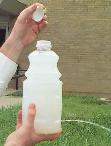
Find a plastic bottle with a tightly fitting cap or lid. Fill it with water, and put on the lid. Then punch a small hole somewhere near the bottom with a needle or a tack or a sharp pointed knife, and let the bottle stand for a few seconds. Then remove the lid, and put it back on again (of course, you will do this over a sink, and expect to get wet).
Now please discuss how this water system is like an electrical circuit.
A. Suppose you found a pipe in your basement, and you wanted to know which way the water goes in this pipe. All you can do is trace where the pipe comes from and where it goes to -- what gets connected. Explain how you would use this information to answer the question.
B. The electrical equivalent to this would be to find a wire somewhere under the hood of your car. Which way does the electrical current go? Again you can trace where the wire comes from and where it goes to. Explain how you would use this information to determine the direction of the current.